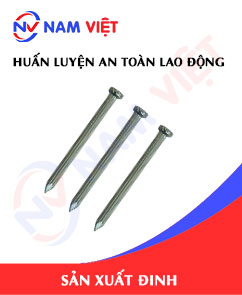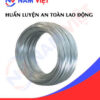Occupational Safety Training For Nail Manufacturing
99,000 ₫
Note: The above price is calculated for one person, the price may fluctuate depending on the number of trainees participating in the course and the movement of the market. For more accurate pricing support, please refer to the quotation or contact directly with our consultants.
Occupational safety is an important issue in nail manufacturing factories and needs to be addressed promptly to ensure the health and safety of workers, as well as to enhance the reputation of enterprises. The Occupational Safety Training course is one of the effective solutions to raise awareness about preventing occupational accidents for workers participating in nail manufacturing.
Table of Contents
Toggle1. Overview of Nails
a. What is a Nail?
Nail (Iron Nail) is a product made from iron, commonly used in construction projects and daily life to connect materials together. Nails come in various sizes and types to suit different purposes. Common types of nails include flat head nails, T nails, rivet nails, twisted nails, hexagonal nails, and many other types.

b. Types of Nail Manufacturing Machines
Types of nail manufacturing machines include:
- Automatic Nail Machines: Automatic nail machines use a mechanical or electronic system to automatically drive nails into materials.
- Semi-Automatic Nail Machines: Semi-automatic nail machines also use mechanical or electronic systems but require an operator to perform the nailing operations.
- Manual Nail Machines: Manual nail machines are simple machines used by nail blacksmiths or carpenters to manually drive nails.
- Artistic Nail Machines: Artistic nail machines are specialized machines used to create artistic products from iron nails.

c. Nail Manufacturing Companies in Vietnam
Some nail manufacturing companies in Vietnam include:
- Saigon Nail Manufacturing and Trading Company Limited (SAIDICO)
- An Phat Nail Manufacturing and Trading Company Limited
- Southern Steel Nail Manufacturing and Trading Export-Import Company Limited (MIDICO)
- Vinafix Nail Manufacturing Company Limited
- Thanh Cong Manufacturing and Trading Company Limited (THACO)
- Son Ha Nail Joint Stock Company (SONHA)
- Phuoc Tien Manufacturing and Trading Company Limited (PTC)
- Viet Hai Nail Manufacturing and Trading Company Limited
- Hung Phuc Steel Nail Company Limited
- Quang Khai Manufacturing and Trading Export-Import Nail Company Limited (DQK).
These are just some of the nail manufacturing companies in Vietnam and do not represent all of them.

d. Specific Jobs in a Nail Manufacturing Factory
Group 1
- Executive Director, Deputy Executive Director, Department Heads in a nail manufacturing factory.
Group 2
- Safety Officers: manage safety within the factory, design safety procedures, supervise and ensure staff compliance with safe working procedures.
Group 3
- Material fabrication and processing: Nail factories use rolled steel to fabricate nails. Before processing, materials are cut with steel cutting machines, then transferred to machinery for manufacturing.
- Nail fabrication: Materials are sent to nail manufacturing machines where they are bent and cut into nails of various sizes and shapes.
- Quality inspection: After fabrication, nails are checked for quality before being distributed. Quality inspection includes checking size, shape, hardness, and durability.
- Packing: After passing quality inspection, nails are packed according to type and size before being transported to dealers or customers.
- Machine maintenance: To ensure the factory operates efficiently, machinery and equipment must be regularly maintained to ensure stable operation and prevent unexpected failures.
Group 4
- Office, service, sales, and marketing jobs.
- Production management, quality management, human resources management, materials management, financial and accounting management.
- Research and development of new products, design of product packaging.

2. Overview of Nail Manufacturing Occupational Safety Training
In this article, we focus on issues related to Group 3 because Group 3 is directly involved in manufacturing and faces the highest occupational safety risks. Refer to other groups here.
a. What is Group 3 Occupational Safety Training?
- Group 3 Occupational Safety Training consists of sessions providing awareness about preventing workplace accidents for workers.
- The occupational safety training course helps workers recognize and prevent hazards, reducing risks of workplace accidents while working.
REGISTER FOR OCCUPATIONAL SAFETY TRAINING SERVICE
b. Training Duration
Initial Occupational Safety Training Duration
- Total training time is at least 24 hours, including exam time.
- 8 hours of theory on policies, safety and labor hygiene laws
- 8 hours of theory on basic occupational safety and hygiene knowledge
- 4 hours of theory on specialized training content
- 2 hours of practice on specialized training content
- 2 hours of theoretical exam at the end of the course
The safety training center will schedule multiple sessions depending on worker availability. Typically, there are 6 sessions over 3 days, provided the manufacturing company arranges continuous learning time.
Periodic Occupational Safety Training Duration
- Before the occupational safety card expires, workers must undergo periodic occupational safety training, with the periodic training time being at least 50% of the initial training time.
Explanation: total periodic occupational safety training time is at least 12 hours, including exam time. After completing the periodic training and passing the exam, workers will have their occupational safety card reissued and extended.
c. Training Content
| No. | TRAINING CONTENT | TRAINING DURATION (HOURS) | |||
| Total | Including | ||||
| Theory | Practice | Exam | |||
| I | Policies and Safety, Labor Hygiene Laws | 8 | 8 | 0 | 0 |
| 1 | Overview of legal documents system on occupational safety and hygiene. | 6 | 6 | ||
| 2 | System of standards and technical regulations on occupational safety and hygiene. | 1 | 1 | ||
| 3 | Specific regulations by state management agencies on occupational safety and hygiene when constructing, expanding, or renovating factories, facilities, and inspecting machinery, equipment, materials, and substances with strict safety and hygiene requirements. | 1 | 1 | ||
| II | Basic Occupational Safety and Hygiene Knowledge | 8 | 8 | 0 | 0 |
| 1 | Basic knowledge of hazardous and harmful factors in the workplace. | 4 | 4 | ||
| 2 | Methods to improve working conditions. | 1 | 1 | ||
| 3 | Safety culture in manufacturing and business. | 1 | 1 | ||
| 4 | Rights and obligations of employers and employees; occupational safety and hygiene policies for employees; roles and duties of safety network members. | 1 | 1 | ||
| 5 | Safety rules, signage, use of safety equipment and personal protective equipment; skills in first aid, accident response, and occupational disease prevention. | 1 | 1 | ||
| III | Specialized Training Content | 6 | 4 | 2 | 0 |
| Comprehensive knowledge of machines, equipment, and substances generating hazardous factors; risk analysis, assessment, and management for occupational safety and hygiene; safe working procedures with machinery, equipment, and substances requiring strict safety and hygiene standards. | 6 | 4 | 2 | ||
| IV | Final Occupational Safety Training Exam | 2 | 2 | 0 | 0 |
| Total | 24 | 22 | 2 | ||
See more training content of 6 groups
d. Occupational Safety Card
After completing the occupational safety training and passing the exam, workers will be issued an occupational safety card (commonly called occupational safety certificate Group 3).
The Group 3 card shows personal information such as name, date of birth, specific job, and working environment. It also includes training duration, a red stamp, and signature confirming course completion.
According to the regulations on issuing safety cards stated in Clause 2 of Article 24 of Decree 44/2016/ND-CP, there are 2 cases:
- If there is an employment contract between the employer and employee, the employer must stamp and sign the safety card for Group 3 trainees after they complete the training from the occupational safety training unit and pass the exam.
- If the worker is freelance or seasonal with no employment contract, the training unit must stamp and sign the safety card for the worker after they complete the training from the occupational safety training unit and pass the exam.

3. Identifying Hazards Affecting Workers in Nail Manufacturing
The hazards affecting workers during nail manufacturing may include:
- Fire and explosion risks: The nail manufacturing process often involves using many machines and electrical equipment along with flammable materials, so fire and explosion hazards are always present during manufacturing.
- Electric shock: The voltage and current in a nail manufacturing factory are very high. Therefore, if safety procedures are not followed when using electrical equipment and proper protective equipment is not worn, workers may suffer electric shocks or serious injuries.
- Machinery injuries: Using machinery in nail manufacturing always carries the risk of impact or finger amputation if proper protective equipment is not worn and safety procedures are not followed.
- Chemical exposure: Workers in nail manufacturing factories may come into contact with hazardous chemicals such as acids, iron compounds, and other organic substances. Without full protective gear like masks, ear protection, and body protection, workers may suffer long-term health damage.
- Temperature and pressure: The temperature and pressure in nail manufacturing factories are usually very high. Without wearing protective equipment such as safety shoes, gloves, and protective clothing, workers may suffer burns or injuries.

4. Common Workplace Accidents in Nail Manufacturing
Common workplace accidents for workers in nail manufacturing include:
- Hand or foot cuts: When using nail cutting machines, workers may cut their hands, feet, or other body parts if machines are not used properly or protective equipment is not worn.
- Puncture injuries: Workers may be punctured by nails if they do not wear adequate protective equipment.
- Burns: While using nail manufacturing machines, workers may suffer burns from contact with hot machines or materials.
- Hearing loss: Loud noise during nail manufacturing can cause hearing loss if workers do not wear ear protection or noise-reducing devices.
- Back pain: Repetitive work over long periods can cause back pain.

5. Safety Measures for Participating in Nail Manufacturing
To ensure worker safety during nail manufacturing, the following safety measures should be implemented:
- Use of protective equipment: Workers should wear safety goggles, helmets, gloves, and safety shoes to protect the entire body while performing tasks.
- Guidance on safety equipment use: Workers should be trained on proper use of equipment to ensure their own safety and that of others around them.
- Safety monitoring: Factories should have a safety monitoring system to track safety issues during manufacturing and implement timely countermeasures.
- Regular inspections: Manufacturing equipment should be regularly inspected, maintained, and replaced as necessary to ensure worker safety.
- Safety training: Workers should be trained to understand the hazards that may occur during nail manufacturing and know how to respond in case of incidents.
- Material and supply management: Materials and supplies should be strictly managed, meeting standards and ensuring safety for workers.
- Quality control: Ensure products meet quality standards without technical defects, thereby minimizing the risk of workplace accidents.
- Periodically conduct occupational environment monitoring in the factory, collecting and analyzing harmful factors to workers, and adjusting to reduce hazards to prevent occupational diseases.
6. Benefits of Occupational Safety Training in Nail Manufacturing
An Toan Nam Viet provides your enterprise with the following benefits after completing occupational safety training courses as stipulated in Decree 44/2016/ND-CP on occupational safety and hygiene for companies and enterprises:
- Workers can recognize potential occupational hazards and take preventive measures to avoid accidents.
- Your enterprise can establish risk prevention measures in manufacturing, operation, and maintenance processes.
- Reduce costs associated with potential workplace hazards.
- Uninterrupted manufacturing increases labor productivity and product quality.
- Compliance with labor safety laws, avoiding legal risks.
- Enhance credibility and professionalism, thereby elevating your brand.
An Toan Nam Viet’s training courses are solutions to prevent external hazards from impacting individuals, helping them avoid injuries or, in severe cases, death.
REGISTER FOR OCCUPATIONAL SAFETY TRAINING SERVICES
7. Customer Feedback After Completing Nail Manufacturing Safety Training
An Toan Nam Viet has years of experience accompanying many enterprises in Vietnam in general and the southern provinces in particular. This responsibility is highly valued, which is why An Toan Nam Viet always focuses on making occupational safety training more professional. Our motivation to grow comes from positive feedback and suggestions from our business partners. Below are feedback examples from partners we have served.
Bac Nam E&C Investment and Construction Joint Stock Company
“The first time using An Toan Nam Viet’s service, I was surprised by the 24/7 support from the consulting team. The class organization was very fast and convenient for our company. Thank you very much for An Toan Nam Viet’s service!”
Hoa Dat Construction and Trading Joint Stock Company
“An Toan Nam Viet’s service helped us a lot in simplifying occupational safety and completing safety records for our work process. The consulting team was enthusiastic and timely. 5 stars for An Toan Nam Viet.”
See more customer interviews after using An Toan Nam Viet services
8. Occupational Safety Training Capacity of An Toan Nam Viet
An Toan Nam Viet is a reputable and high-quality center for occupational safety training in Vietnam. Safety training sessions are continuously held at factories, workshops, or construction sites across all 63 provinces of Vietnam.
REGISTER FOR OCCUPATIONAL SAFETY TRAINING SERVICES
Occupational Safety Training License
- An Toan Nam Viet has been inspected and certified by the Department of Safety under the Ministry of Labor – Invalids and Social Affairs, granting the certificate for full eligibility to operate occupational safety and hygiene training. This further strengthens our capacity in occupational safety training.

Materials and Lectures
- Before being used in occupational safety training courses, training materials are reviewed and approved to ensure accuracy and effectiveness when applied.
- Our instructors follow teaching methods standardized by An Toan Nam Viet, developed by experts in occupational safety and hygiene training to maximize knowledge retention for trainees.
Facilities
- Controlling classroom factors that affect training enhances teaching efficiency and knowledge absorption.
- Our training facilities provide spacious classrooms that meet standards for area, lighting, and training equipment, etc.
9. Nationwide Reputable Occupational Safety Training Center
At An Toan Nam Viet, we prioritize the professional dedication of occupational safety training. For us, teaching workers to protect themselves equips them with safety knowledge essential for their work and contributes to national development.
To ensure effective training, we meticulously prepare every detail, from tools, teaching equipment, curriculum, materials, to audio and lighting.
Our occupational safety instructors are experts with years of experience. They have conducted research to identify hazards across industries and teach prevention methods.
Lectures are practical, vivid, and easy for workers to understand, ensuring comfort and effective knowledge absorption. All content strictly follows Decree 44/2016/ND-CP.
Workers learn preventive measures and self-protection techniques, applying them appropriately in real work situations.
Our training center is proud to provide reputable, professional occupational safety training with the following advantages:
- Competitive training costs while ensuring high-quality instruction.
- Flexible training schedules tailored to company manufacturing operations.
- Fast and legally compliant procedures for issuing occupational safety training certificates.
- Experienced instructors with long-term expertise.
- Classroom environment controlled to enhance teaching efficiency and knowledge retention.
- Lessons designed to suit occupational safety requirements of enterprises.
- An Toan Nam Viet works diligently and professionally to provide precise and timely support to clients.

10. Additional References for Nail Manufacturing Safety Training
- Occupational Safety Training Materials Collection
- Nail Manufacturing Occupational Safety Materials
- Occupational Safety Training Test
- Nail Manufacturing Occupational Safety Training Curriculum
- Nail Manufacturing Occupational Safety Multiple Choice Test
1 review for Occupational Safety Training For Nail Manufacturing
No comments yet















namchinh.haiphong341
Dịch vụ lắm nhé! tôi rất hài lòng với cách làm việc của trung tâm